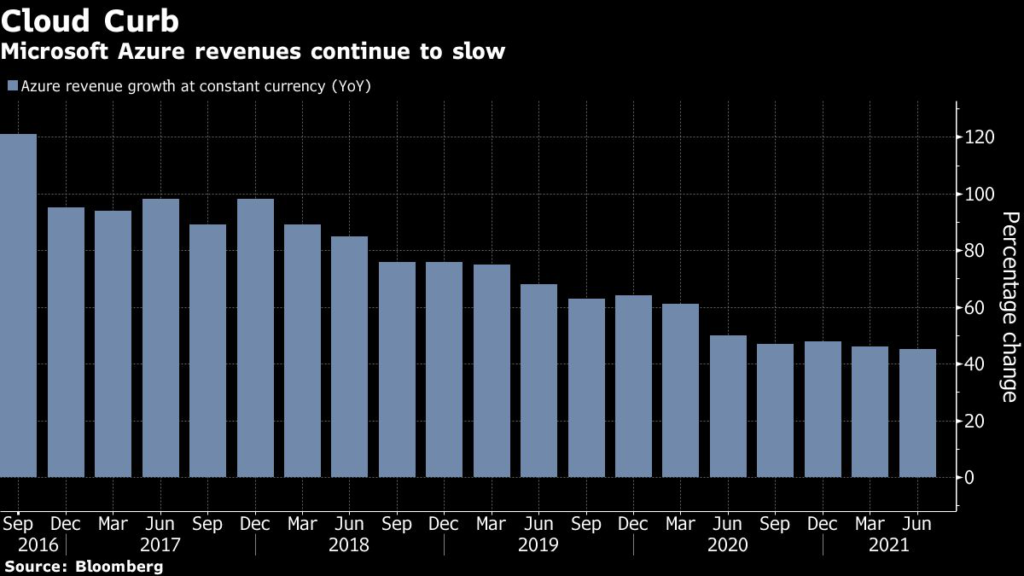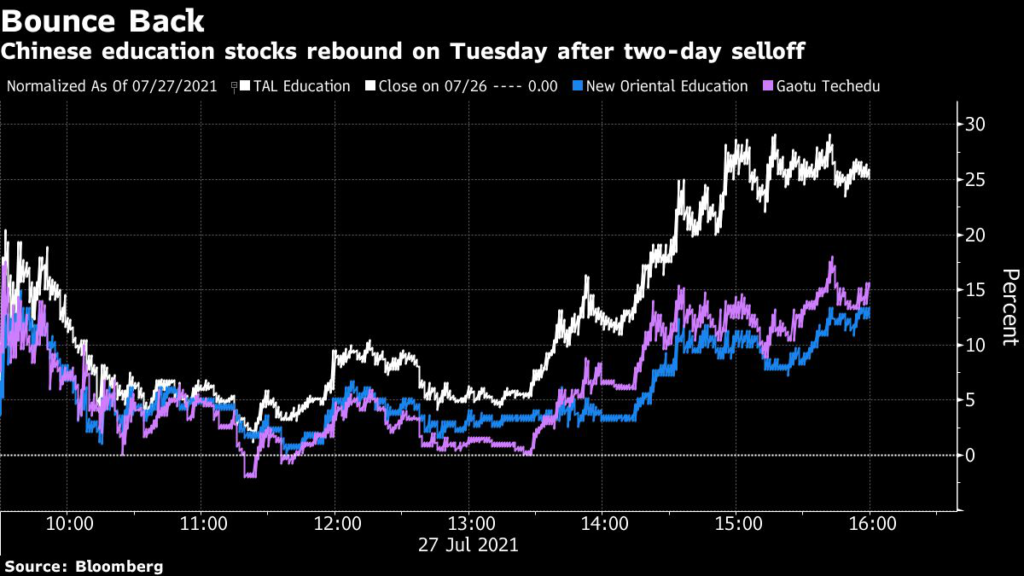Microsoft Sales, Profit Gain; Shares Drop on Azure Concern
(Bloomberg) — Microsoft Corp. reported sales and profit that exceeded analysts’ estimates for a 10th straight quarter, though investor optimism was tempered by concern about slowing growth in the software giant’s Azure cloud-computing business. Shares slipped in late trading.
Sales in the fourth quarter, which ended June 30, climbed 21% to $46.2 billion, the Redmond, Washington-based company said Tuesday in a statement. That compared with the $44.3 billion average estimate of analysts polled by Bloomberg. Net income rose to $16.5 billion, or $2.17 a share, while analysts had predicted $1.92.
Microsoft’s market value now tops $2 trillion, and the high-flying shares have led investors to expect results to outdistance projections by a wide margin. Azure’s sales increase of 51% in the period disappointed some investors because it was partially fueled by currency fluctuations — the number drops to 45% without that boost, representing a slowdown from the prior period. While Azure has been growing steadily, the business faces steep competition for big corporate deals from Amazon.com Inc., the dominant cloud service, and Google, which ranks third in the market but is pouring resources into the business to catch up.
“People are not happy if Azure decelerates — they’re worried the good days are over,” said Mark Moerdler, an analyst at Sanford C. Bernstein. “People seem to worry Azure will never be as big as Amazon.”
Azure revenue had gained 50% from a year earlier for the two prior quarters, not taking into account currency fluctuations. In constant currency, Azure posted a 46% sales gain in the March quarter.
Microsoft shares dropped about 2.6% in extended trading following the report, after declining to $286.54 in New York. The stock rose 15% in the fiscal fourth quarter, compared with 8.2% for the S&P 500 Index, reflecting investor ebullience about growth prospects for Azure, Office, artificial intelligence and gaming. The recent period marked the second quarter in a row that initial analysts’ notes highlighted Microsoft’s better-than-expected performance in sales and profit, while shareholders were less pleased with specific details.
Still, Chief Financial Officer Amy Hood hailed the Azure performance as better than she had forecast and said demand remains strong across all of Microsoft’s cloud businesses, including Azure, Office and Dynamics software services.
“Forty-five percent was both better than we expected and driven by consumption growth, which is very good,” said Hood, in an interview. “Demand is healthy, the overall execution was better than I expected.”
Commercial cloud sales in the fiscal third quarter rose 36% to $19.5 billion, Microsoft said. Gross margin, or the percentage of sales left after subtracting production costs, in that business widened 4 percentage points to 70%, the company said in a slide posted on its website. Total company gross margins have been benefiting from an accounting change that’s related to current and future server and network equipment, and this may be the last quarter where that leads to an improved margin, according to Bloomberg Intelligence analyst Anurag Rana.
“This year has been great because of the accounting change but that particular boost is hiding the fact that gross margin is being hurt by the faster-growing Azure business,” Rana said before the results.
In the Productivity unit, mostly made up of Office software, sales were $14.7 billion, compared with an average analysts’ estimate of $14 billion. LinkedIn, which Microsoft acquired in 2016, became the third business in three years to top $10 billion in annual revenue, Hood said, and Teams, the Microsoft product that competes with Slack Technologies Inc., reached 250 million monthly active users, a huge jump from the 145 million the company reported in April.
Sales of Intelligent Cloud products, made up of Azure and server software, rose to $17.4 billion, above analysts’ expectations for revenue of $16.4 billion.
In the More Personal Computing unit, which includes products like Windows, Surface and Xbox, sales were $14.1 billion. Analysts had expected $13.9 billion. Sales of Windows software sold to PC manufacturers declined 3%, a drop that reflects the surge in laptop buying in the same quarter a year earlier, when Covid-19 lockdowns were forcing many workers to do their jobs remotely.
Overall gaming revenue jumped 11% in the recent period, Microsoft said, with Xbox hardware sales more than doubling. A global semiconductor shortage has constrained sales of Xbox consoles following the release of a new machine late last year, and growth in video-game and gaming services fell 4% in the quarter compared with the pandemic-boosted year-ago period.
Component shortages are also hurting PC and Surface availability, Hood said. Surface sales dropped 20% in the quarter. Hood expects some impact from chip and part shortages to persist into the new fiscal year, which began July 1.
(Updates with CFO’s comments starting in seventh paragraph.)
More stories like this are available on bloomberg.com
©2021 Bloomberg L.P.





